Last updated on December 13th, 2021 at 11:01 am
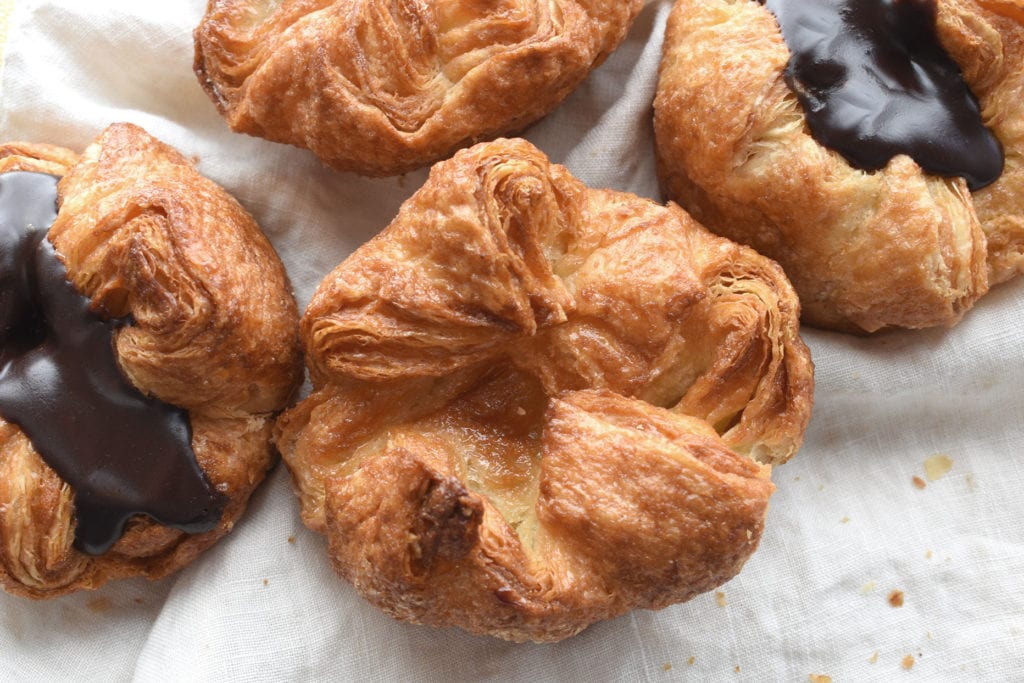
If you’ve ever had the pleasure of eating this delightfully gooey pastry, the OG version might not be quite what you thought it was.
Kouign amann are not new, but they’re fairly new to Americans. If you’ve never experienced the joy of pulling apart the delicate, maddeningly delicious layers of these sweet treats, I would recommend dropping everything right now and finding one.
A few years ago, they were a bit of an obsession of mine, but for the holidays I decided to make the big version of the traditional kouign amann. The obsession was quickly reignited—I went down an internet rabbit hole only to learn that what I thought of as a kouign amann is not like the original cake at all. And it’s only three ingredients.
That hole got a lot deeper—and I am still going down it.
The French Kouign Amann
Kouign amann is a legit pastry with an origin that can be traced back to France, of course. This “butter cake” originated in the coastal town of Douarnenez, Brittany. To make it confusing, kouign amann are not really cakes. Put simply, they’re made up of buttery dough coated in sugar (granulated sugar or caster sugar) that is transformed into caramel-y, flakey shells with gooey, buttery centers. The devil himself could not have come up with something so sinful.
The invention of the cake itself was an accident (like most things we love). This delicious mishap, according to local lore, happened around 1860 during a flour shortage and a butter surplus. The inventor was apparently trying to make the most of a small scrap of dough. He threw some mixture of butter, sugar and dough together into the oven and out came the kouign amann.
They’re typically made the size of a standard cake, but they can be made in different sizes. Individual servings are called kouignettes (the size you’ll find in the United States which are typically made in a muffin cup).
The real mystery is why few French people outside of Brittany are familiar with it. It boggles the mind.
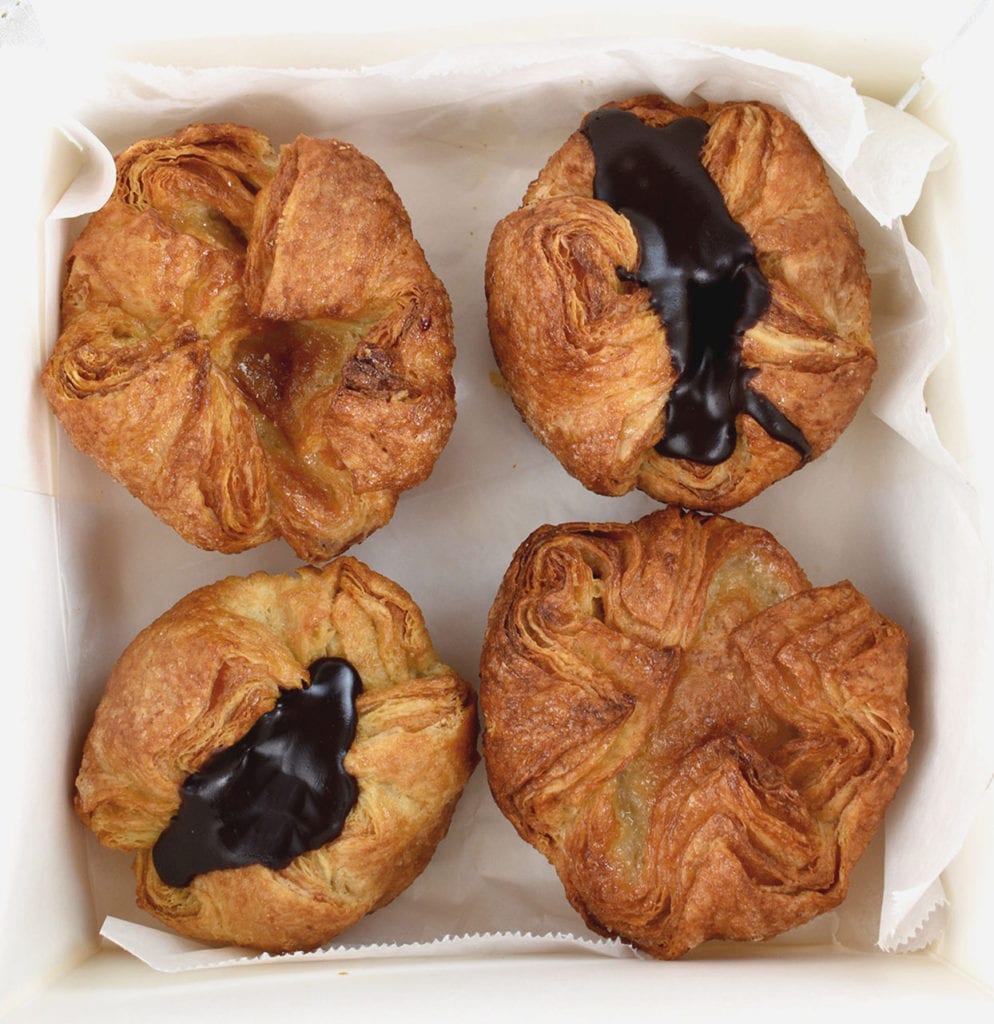
American Curiosity, French Pastry
Pronounced “queen ah-mon,” kouign amann allegedly started popping up in bakeries in California sometime around the cronut craze of 2013. Some have called them the West Coast’s answer to New York’s Frankenstein pastry (from Dominique Ansel), but some deep Googling reveals that the first bakery to serve them west of the Mississippi was Les Madeleines in Salt Lake City (the website says it was the third in the nation to sell them—still trying to find where the first two are).
I stumbled upon that information on a Reddit thread from 2009—a person on the thread said they used to be a baker there and that a Martha Stewart recipe was pretty close to what they used (I’ll get to that recipe later).
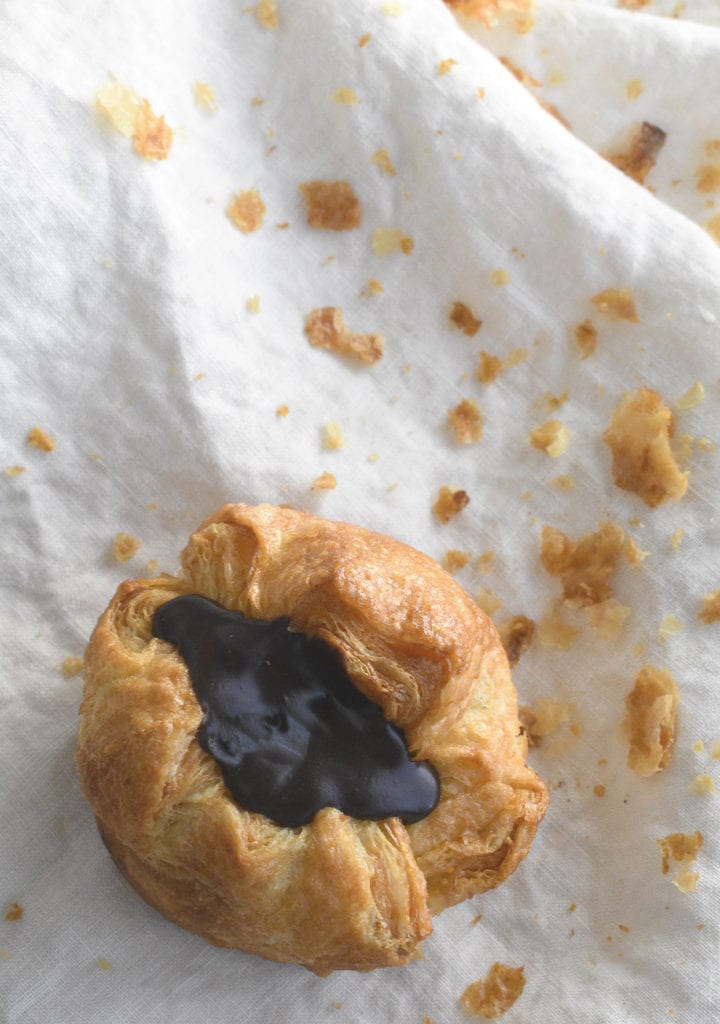
Diminutive Danish
b. Patisserie in San Francisco delivers a dreamy KA. As a testament to its baking authority, after several years of being nominated for the James Beard Award for Outstanding Baker, the owner received the honor in 2018.
The bakery bubbles with enthusiasm for its signature flaky pastry—it launched a campaign to declare June 20 National Kouign Amann Day (success!). It also sells kouignette key chains that capture its unique aesthetic—the corners of the plastinate dough are pulled toward the center before baking to showcase the layers of yeasted dough that can be filled like a Danish or left plain.
But it wasn’t the first bakery in the Bay Area to bake up these gems. The NYTimes mentioned the confection for the first time in 2011 (calling it “the fattiest pastry in Europe”) and pointed to Starter Bakery in Berkeley as a purveyor—they’re less croissant-like than b. Patisserie’s. Peet’s Coffee (also started in Berkeley) was serving them (from a wholesaler) as early as 2009—they used to be my Friday morning treat. They’re similar to the ones from b. Patisserie—sweet, buttery and Danish-like.
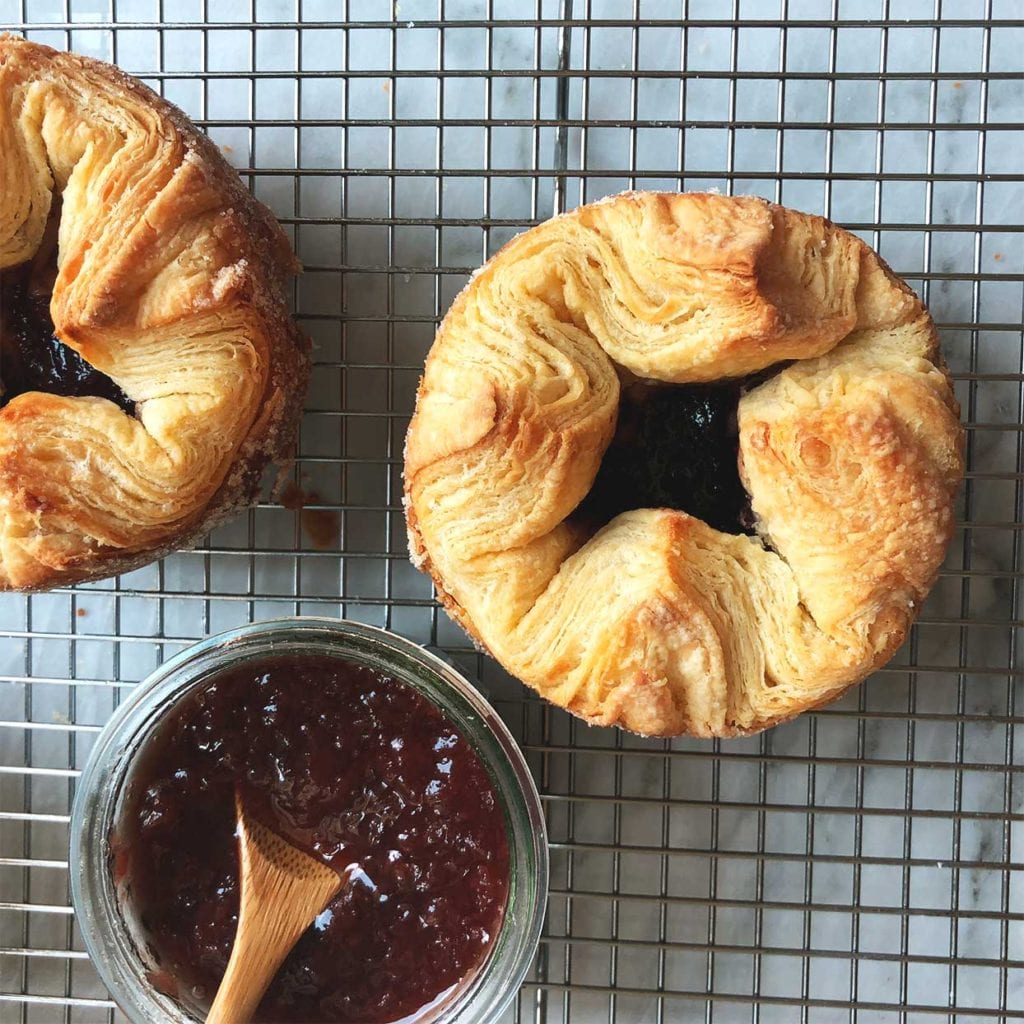
Questionable Kouign Amann
I’ve made more than a few kouignettes with varying degrees of success. I mentioned that KA are made of layers of dough and butter (laminated dough) like croissants with the addition of sugar. But it’s a bit more complicated than that.
I’ve used several different recipes (Bon Appetit, Chef Steps, America’s Test Kitchen, and more)—some of them were a bit messy so I came up with one of my own (pictured above). The results are similar to the b. Patisserie and Peet’s version. I start with a basic croissant recipe and press the sugar into the sheet of dough on each side before putting it into a mold prepared with butter and sugar to create that caramel-y experience.
For our holiday kouign amann, I studied pictures on the internet of the family-sized KA. I found that they look nothing like what I was familiar with. And it occurred to me that maybe Americans are making them wrong.
The Right Recipe
I did a lot more sleuthing for a true French recipe. I found a French guy who did a Facebook Live making the big version. He made it look easy, but it wasn’t entirely different from the other methods I attempted. I tried his way. The dough was loaded with butter and sugar. It was very messy.
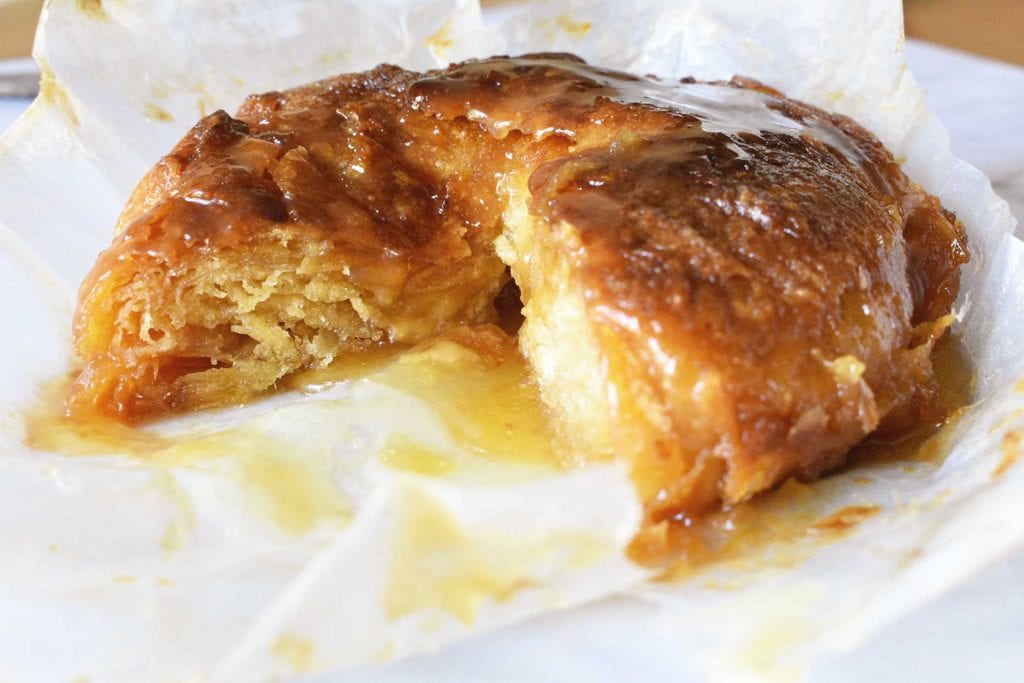
As I was putting the French recipe in the oven, my husband asked me, “Is that going to be disgusting?”
That comes from a man who thinks says everything I make is amazing (except that spaghetti squash casserole that we’re still recovering from). It doesn’t suck being loved that much, but it does say a lot about how terrible the pre-baked kouign amann looked.
He took back the comment after sampling approximately half of the cake. It was life-changing. But it was nothing like the kouign amann from the bakeries. It was crunchy and caramel-y, delightfully gooey and the layers of dough drowned in the melted butter-sugar mixture, unlike the flaky American version. And forget about chocolate fillings—adding anything else would be gilding the diamond-studded lily. It’s plenty rich on its own.
Digging Deeper
Still second-guessing myself, I looked at the pictures of KA from bakeries in Brittany—they all look like my delicious, messy cake and nothing like the ones I buy. One should not be so obsessed with a pastry but I am, so I emailed the French baker.
“The kouign amann you have in America are really different.”
Bernard of La Cuisine de Bernard
I don’t speak French. When I came up with the idea, I didn’t know how I was going to ask all my questions about flakiness and gooeyness and everything in between. However, after several months of lockdown and binging seven seasons of 90 Day Fiance, it dawned on me that if two people can fall in love communicating solely through Google Translate, I can compose a thoughtful letter about pastries in French as if it were my first language. It was an epiphany.
I could only hope for a response.
The OG Kouign Amann
“The kouign amann you have in America are really different,” Bernard of La Cuisine de Bernard tells me.
He’s been making the OG KA since he was 13—he spent all of his summers in Brittany. He says he’s never seen a kouign in the United States the way they make them in Douarnenez.
Despite his expertise in baking kouign amann, he decided to take a class on how to make this wily pastry when he was in New York City. I was a bit gutted when he described the lecture.
”They made kouign amann with croissant dough, unsalted butter and brown sugar,” he scoffed. “I don’t agree at all!”
He says the original recipe he uses calls for salted butter, bread dough and sugar. You read that right: Kouign amann only require three ingredients. THREE INGREDIENTS.
“It is not a fancy cake,” he explained and went on to say the OG KA has a…rustic appeal. “Its imperfections make it perfect for my eyes.”
I found it interesting that he pointed out the same thing my husband did. It’s almost as if Americans took the OG KA and said, “This just doesn’t seem French enough, so I’m going to make the recipe really complicated and jack up the prices.” I’m a little jaded.
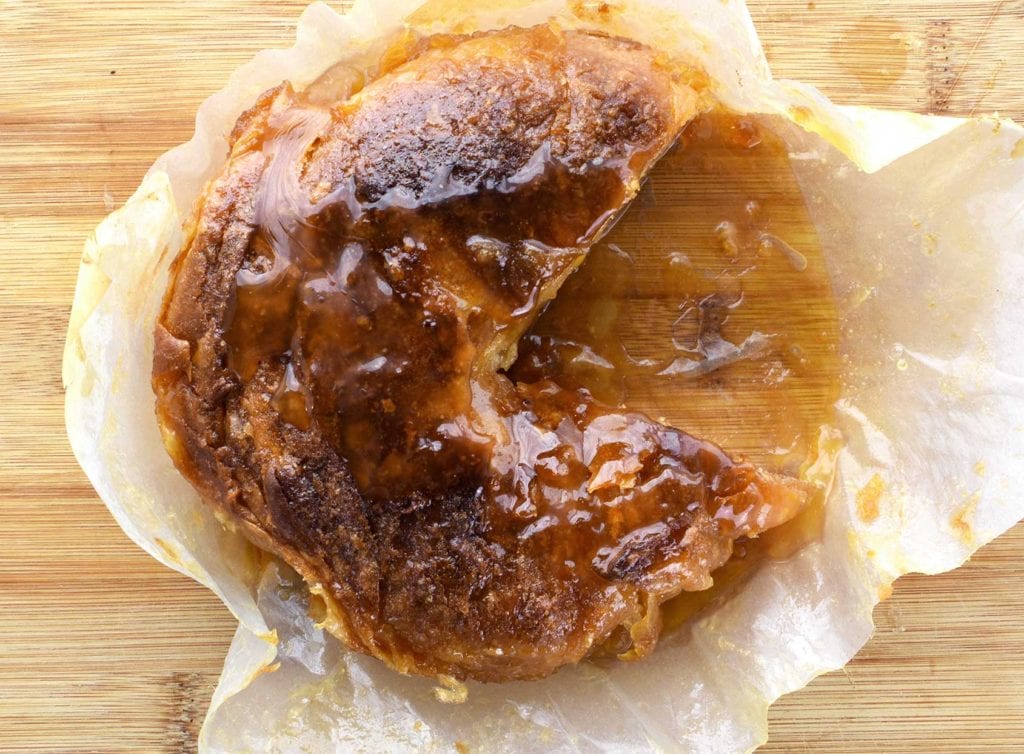
Pastry Designation
France takes food and beverage very seriously—they have legal designations for certain French items and the production and ingredients must be used precisely to carry names like “baguette” (which has to weigh 250 grams) or “Champagne” (which has to be produced in the Champagne region or it’s just sparkling wine). The good people of Brittany believe the kouign amann formula has earned its designation with a ratio of 30 percent butter, 30 percent sugar and 40 percent dough.
Few of the American recipes I used follow that ratio (Chef Steps does!) and that Martha Stewart recipe allegedly used at the SLC bakery is waaaaay more complicated than dough, salted butter and sugar.
Making American KA vs French KA
Now that I’ve been exposed to the method of the OG KA, I’m kind of shocked at how Americans injected so much labor into this cake. These are the major speed bumps Americans inserted into kouign amann recipes:
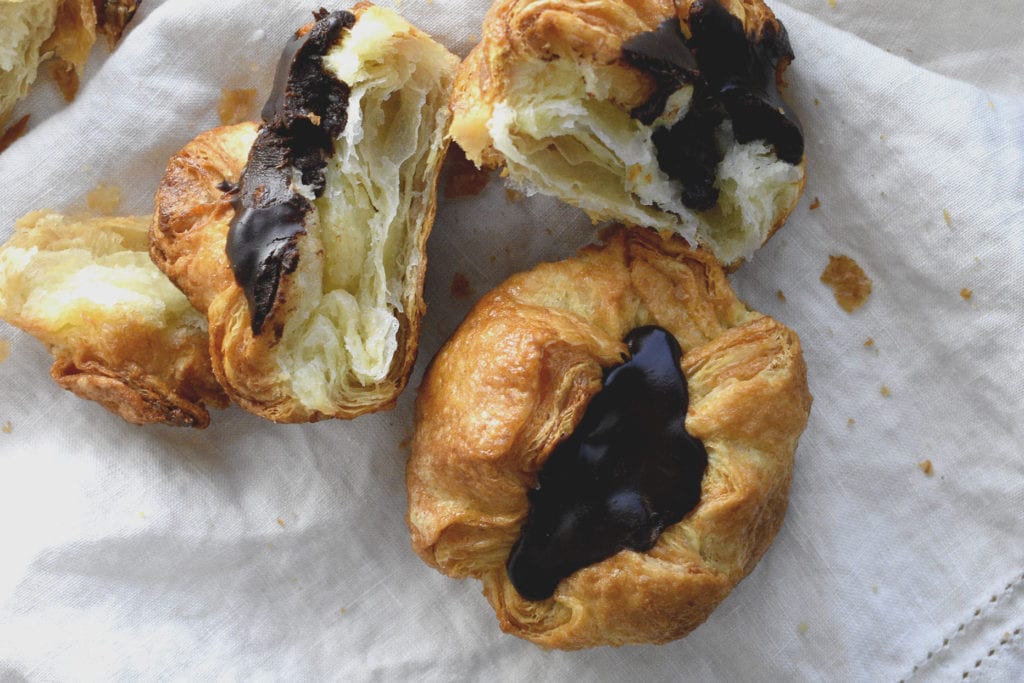
Dough
The OG KA very specifically uses bread dough while the American recipes call for croissant dough. The baker who committed the original sin was trying to make the most of his bread dough when he stumbled on his crowning glory.
The difference between croissant and bread dough is negligible (a poolish, milk vs water, pastry flour vs bread flour and some sugar), but what makes the French version so convenient is that you’re more likely to have bread dough sitting around (we’ve all been making plenty of sourdough!) than croissant dough.
Once you’ve decided on a kouign amann dough (either the challenging American croissant dough or the simple French bread dough) puff pastry, the chilled dough is rolled out on a lightly floured surface. You then roll the pastry dough into a rectangle. Butter and sugar are then sort of folded into the dough using a rolling pin. The dough is then transferred to a cake pan and baked. It’s simple-ish.
Daring Designs
For American kouignettes, you would then cut the finished dough into 12 squares and place them in the cups of a muffin tin. The corners of the dough are then folded into the center before baking. When you’re ready to bake, you’re welcome to fill them with chocolate or jam or sweetened cream cheese.
Bretons make it easy on bakers. Instead of cutting out perfect squares of dough to fit in a 12-cup muffin pan, the sheet of dough is rolled up (like a cinnamon roll) and sliced before going into a mold. When it comes out of the oven, the layers are swirled together instead of being folded into the middle and you get a healthy dose of caramelized sugar.
You won’t be disappointed either way you do it—you’ll still end up with a delicious, golden brown pastry.
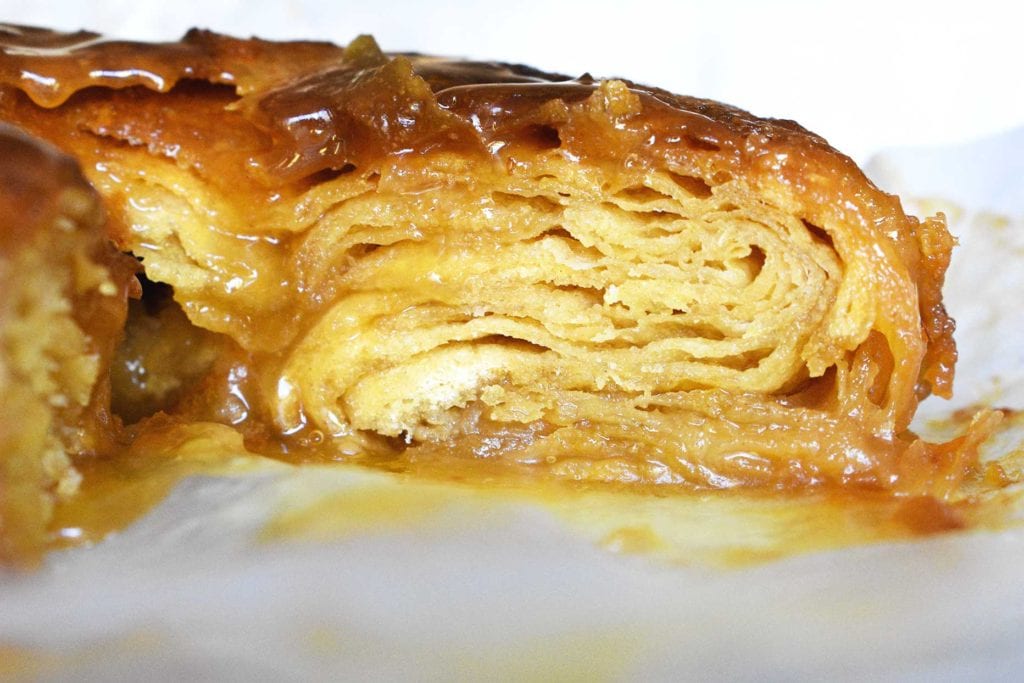
Butter
In addition to kouign amann, Brittany is known for its butter. Its richness is credited to the quality of the cows and the grass they feed on as well as the “kneading” of the butter (instead of churning).
The butter in Brittany is also salted—which is a bit of a levy anomaly. That dates back to the Middle Ages when there was a salt shortage. The King of France imposed a tax on salt everywhere in France except Brittany. They continued to add salt to the butter which made Brittany butter a luxury. This is also an important point in the kouign amann recipe—you have to use salted butter. The American recipes call for unsalted butter.
Most baking recipes (French included) call for unsalted butter. Maybe salted butter didn’t even occur to the first American baker to attempt these pastries.
Measuring
All of the American recipes I used have you measure the length and width of the butter block and dough. It’s extremely precise, like a croissant. But the OG KA is a bit more carefree. You roll out the dough and then you put a layer of butter and sugar on top and fold the dough over the butter and sugar to create a big dumpling to roll out and fold. Without all the measuring, the method is remarkably easy.
Chilling and Sugar
In the American recipes, chilling the dough between “turns” is part of the steps—as it is for croissants. It makes the process extremely long.
For the OG KA, you roll, turn, roll, turn, roll, turn, roll, turn, bake. Easy peasy.
The sugar is what makes it tricky. Some recipes call for the butter and sugar to be mixed together and chilled before layering it with the dough. The OG KA has the sugar sprinkled into the butter layer and there’s no need to refrigerate it. Either way, in my experience, the extra time for chilling makes the sugar “weep” (it turns to liquid) and you end up with a huge mess. I’m not suggesting you let the dough and butter warm up to room temperature, just work REALLY QUICKLY.
The bottom line: If you want an easy and delicious recipe, go with the French version. If you want something croissant-like, go with the American version.
The British Version
I may have been too quick to judge American bakers for taking liberties with such an interesting pastry. After I did all my internet research hands-on training, I fortuitously caught the episode of the Great British Baking show in which the bakers were challenged with making a KA. Turns out, Paul Hollywood’s KA recipe is strikingly similar to the American version. Given Brittany’s geographical proximity to the UK, it’s possible that it was someone of British descent who adapted the recipe to make something more croissant-like.
Cultural Appropriation?
The American kouign amann is different from the French kouign amann in much the same way a Mexican tortilla (a soft flatbread) is different from a Spanish tortilla (an omelette). They’re not the same thing at all, but they’re both delicious and both have their own merits and charm. Is this cultural appropriation? Probably, but I’m still on the fence as to whether or not it’s offensive.
In Peru, there’s an entire cuisine dedicated to fusing Chinese and Peruvian dishes—it’s called “chifa.” Chifa is kind of like how Tex-Mex fuses Mexican and Texan cuisine.
Greece and Turkey both claim baklava as their own.
And even within countries, there are battles over food. New Jersey is divided over processed meat. Half of the state calls it pork roll and the other half calls it Taylor ham.
All dishes are derivative dishes. Different cultures have been borrowing and stealing recipes from other cultures for at least a millennium—it’ll continue for another millennium. That said, whether you order an American kouign amann or you make the OG French kouign amann, YOU WILL ENJOY IT.
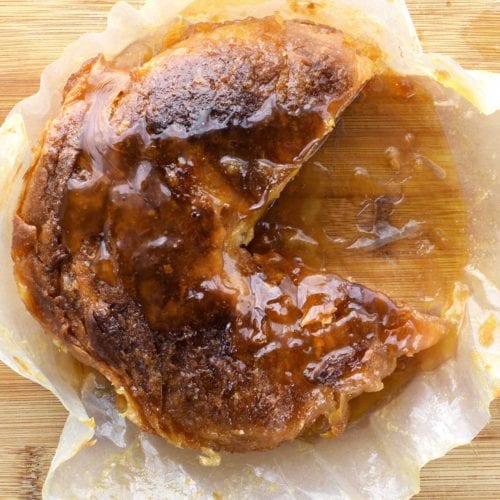
Kouign Amann
Equipment
- Heavy rolling pin
Ingredients
- 1 lb Prepared pizza dough (16 oz.)
- 12 oz salted butter (I like Plugra or Kerry Gold)
- 12 oz granulated sugar
Instructions
- Place cold butter between two pieces of parchment paper. Using a rolling pin, pound it out as thinly as possible without it breaking (about 1/4").
- On a lightly floured surface, roll out the dough to a 1/8" thickness.
- Place butter on top of the dough making sure that the rolled out dough is big enough to envelope the butter completely when folded over.
- Sprinkle all the sugar on top of the butter. Try to make the layer of sugar as even as possible.
- Fold the dough over the butter and sugar and seal the edges so that no butter or sugar is peaking out.
- Using the rolling pin and working very quickly, pound the dough envelope until it's very thin, but be careful that the sugar doesn't tear through the dough.
- Fold the dough into thirds like a piece of paper so that you have a rectangle.
- With the seam side down, pound the dough again until it's thin, but stop before the sugar seeps out.
- Repeat the last two steps.
- When you have a big square, fold in the corners to make a smaller square. Repeat this step to make it an even smaller square.
- Place the dough square in a 9" cake pan lined with parchment paper, cover in plastic wrap and proof for 1 hour.
- Preheat oven to 375F.
- Bake cake until the top is golden brown, approximately 40 minutes.
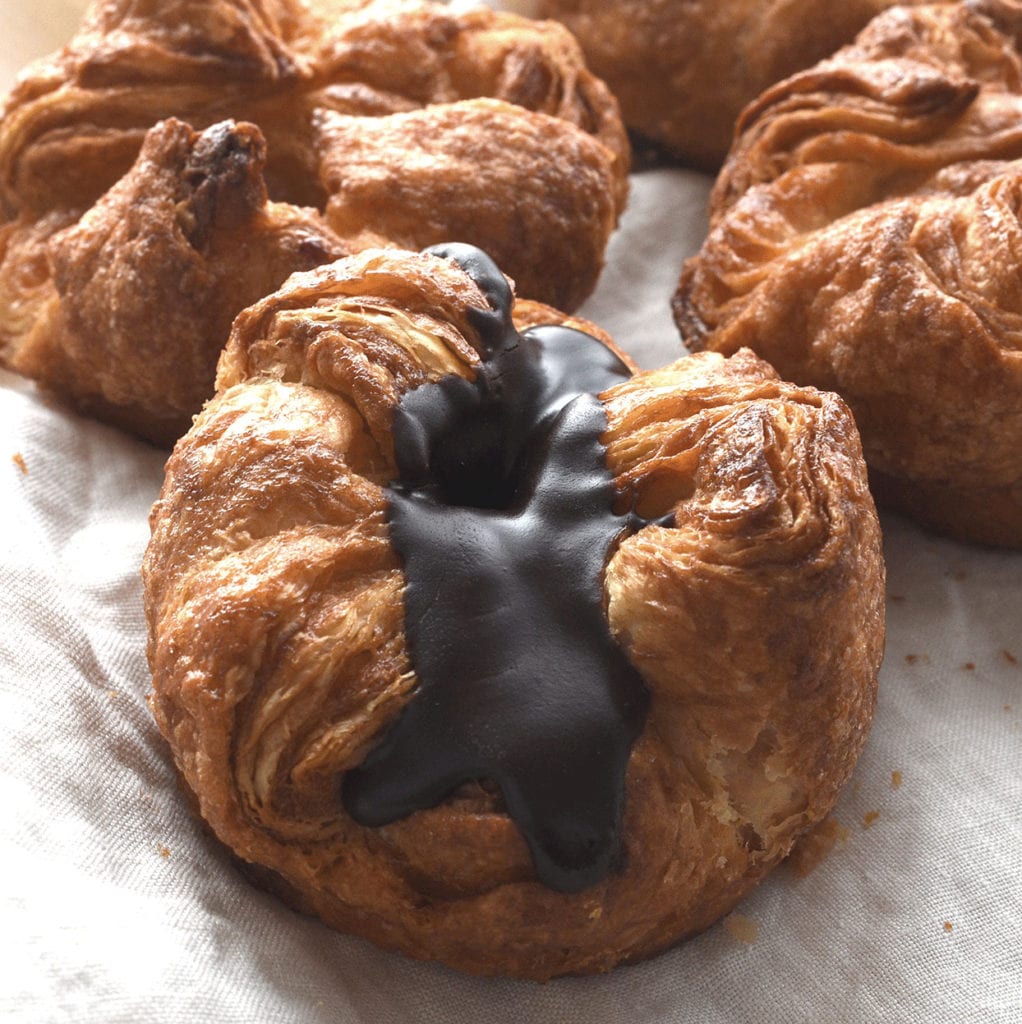
Related Content:
Cranberry Layer Cake with Cream and Walnuts
Millionaire Bars with Almond Butter Shortbread
Kabocha Pie with Gingersnap Crust
TikToker Worth Following:
Other questions:
How to pronounce kouign amann: queen ah mon
Can you freeze kouign amann? Yes, you can freeze kouign amann, but it probably won’t be the same when you thaw it. It will be more chewy and less flaky—kind of like what happens to a croissant when you freeze it.
How to store kouign amann: You don’t really want to store kouign amann. The American version can last about a day (same as a croissant), but the OG KA should be eaten fresh and warm.
Can you make kouign amann with puff pastry? Yes, you can make a descent kouign amann with puff pastry. Just sprinkle granulated sugar on the dough and roll it out slightly with a rolling pin, cut the dough into 5-inch squares, butter and sugar your muffin tin and then fold in the corners of the squares to put in the tin cavities. Bake until they’re golden and you’re done!
How to fold kouign amann: To fold a kouign amann, all you do is bring each corner of the square to the center and gently press down so it sticks long enough to place it in the muffin tin. When it bakes, it will puff up and unfold in an elegant way.
Do you need yeast dough? Whether you want to make a real KA the way Breton bakers make, you want to make the flaky American kind or you have to make exactly what they tried for the Great British Bake Off, you need a yeast dough.
If you happen to be making a fresh loaf of bread, just grab a piece of that to roll out with a butter slab.
But if you want a straight recipe that’s a good representation of the original Breton pastry, the Bon Appétit recipe is pretty good. If you happen to have croissant dough made with fresh yeast on your work surface, you can shake off the excess flour, butter and sugar your muffin tins and fold the dough into a shamrock and bake! But that will only make you small KAs. If you want to make a big one, make sure you have plenty of people to serve it to. It doesn’t travel well and it definitely doesn’t age well—even when it’s rolled in plastic wrap lined with parchment paper.
Kouign Amann near me: If you’re buying a kouign amann from a bakery, they don’t always get them right. Anytime I find the option at a bakery, I get one (I go to A LOT of bakeries—my recent favorite is Bakhaus in San Mateo). I’ve been disappointed—even by great bakeries that know how to make good croissants. I have a favorite bakery in San Francisco (that shall go unnamed) that bungled the pastry. However, if you want a good one (that’s not from b patissier), they are available!
Arsicault makes one that has all the right flavors, but it has a swirled shape (this might have been inspired by the OG KA) instead of the sort of Celtic cross shape. What you should look for if you want a good one is the signature caramel on the outside of the pastry—if it looks dry, don’t bother.
(Update: The Food Network declared the Les Madeleine KA “the best thing” they ever ate—you can order the pastries through Goldbelly).